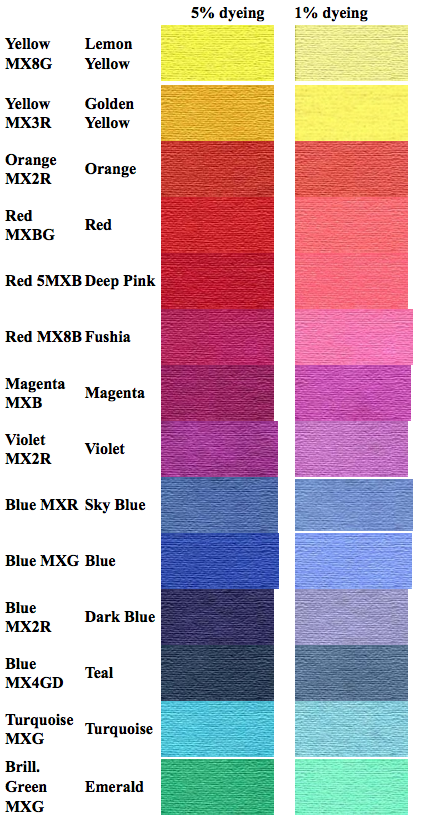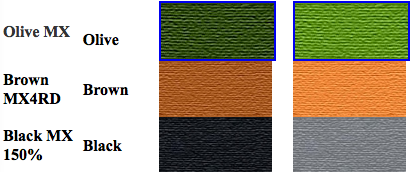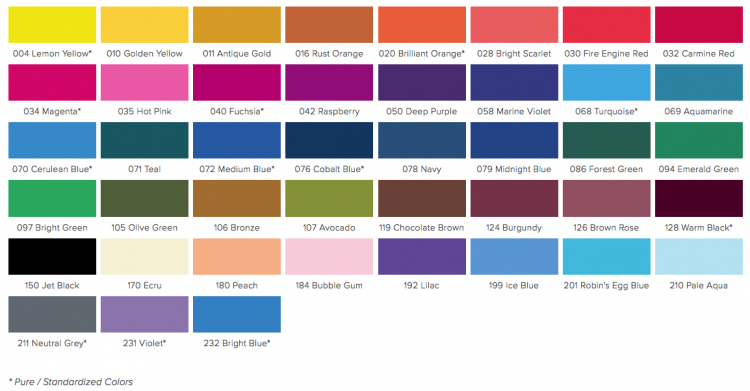Procion MX
Cold water reactive dyes used for dyeng coton. Can also be used hot (80o) at pH 5.5 (week acid) for dyeing of Silk & Wool.
Procion MX are high reactivity dye, and as such are not stable in water solutuion . Dissolved Procion MX dyes intended for handpainting have to be used within 30 minutes, leaving them longer will result in paler dyeing.
| 50g | $12.00 |
| 100g | $22.00 |


PROCION MX HAVE EXACTLY THE SAME DYEING RECIPE AS DRIMARENE-K DYES.
We also stock the Jacquard brand of Procion MX dyes. 43 colours 18g $9.50 each

Dye Instructions
Cold water fibre reactive dyes, suitable for dyeing on cotton, silk, jute, rayon and hessian. Can not be used on synthetics or fabric that has been coated with resin or drip-dry finish. All colours are completely inter mixable.
Unique property of Drimarene-K dye is stability in water solution. They will keep for weeks without any adverse results or loss of colour strength providing nothing else has been added to the dye solution.
The dyes can be applied by 6 different methods to suit your needs:
1. Dip dyeing
2. Hand painting - chemical water fixation
3. Hand painting - Drimafix fixation
4. Tie dyeing
5. 4 Minutes rapid fixation method
6. Polychromatic printing
DIP DYEING PROCESS
The following table sets out the amounts of dye and chemicals required for successful dyeing. It must be remembered that WEIGHT OF DRY MATERIAL determines the quantities of water, dye, and fixing agent.
For every 100 grams of material you need:
(lower figures are for medium shades)
2 litre of water
3-5 gr. dye
80- 100g salt
30- 40g soda ash
60- 90 minutes fixation
1. Dissolve dye (granules by sprinkling on top of lukewarm water - powders by dissolving in very hot water) then add required amount of water.
2. Immerse cloth and agitate to ensure even penetration.
3. Dissolve kitchen salt in hot water and add it to the dye bath. Agitate for 10 minutes.
4. Dissolve Soda Ash in little boiling water and add it to the dye bath. This will start a chemical reaction which will fix the colour to the material. Leave for 60-90 minutes depending on required depth of shade. The material should be periodically agitated.
5. Rinse material under cold running water for ,then rinse in boiling or very hot water containing 1gr of SYNTHRAPOL per litre of water.
6. For Scarlet, Turquoise & Green use Sodium Sulphate instead of kitchen salt
The word "cold" fibre reactive dyes does not necessarily mean that they should be used in cold water. All "cold" reactives, who ever the manufacturer is, are designed to function at their optimum between 35 - 50 centigrade (95 -122F).
After dyeing is finished, the dye bath is completely exhausted and can not be reused.
HAND PAINTING PROCESS
1. Dissolve 10g DR-33 thickener in 1 litre of cold water add teaspoon of acetic acid, stir. If no thickener necessary omit step 1
2. Dissolve
A. 60g Urea and 5g Resist Salt in a little hot water.
Automatic weight & volume calculator
B. 40g Soda Ash and 25g Bicarbonate of Soda in a little boiling water.
3. Combine A and B together and add cold water to make 1 litre, bottle and use as needed.
4. Dissolve dye, add prepared A & B solution and DR-33 ( or Manutex) paste. Adjust to required consistency by adding either more A&B solution (or DR-33 paste if thickener is used).
Once the chemicals are added to the dye solution the prepared mixture must be used within hour.
5. Apply to fabric and leave to dry as long as possible, then rinse in cold water containing SYNTHRAPOL and few drops of vinegar.
DRIMAFIX PROCESS
DRIMAFIX is a one step fixing agent for use with DRIMARENE-K dyes. DRIMAFIX opens up new ways of exploring the full capabilities of Drimarene-K dyes by allowing the application of as many colours as one wish, with an easy and simple fixation process. It is now possible to treat a piece of cotton or silk material the same way a painter uses a canvas... simply paint on your design in as many colours as desired and when finished apply DRIMAFIX over the entire work for one step multi-colour fixation. There are no more messy chemicals to worry about.
1. Dissolve Drimarene-K in water ( For strong colour use 1gr of dye to 20 ml water, and for pastel shade use 1gr of dye to 200 ml of water). Do not add any chemicals. Apply the colour directly to the material with a paintbrush. Once the painting is completed, it should be left until it is completely dry.
2. Place the painting on a plastic sheet, which is slightly larger than the painting.
3. Apply DRIMAFIX over the entire painting with a brush or squeegee. Roll the whole thing up like a sausage, making sure that the ends are sealed to prevent it from drying. Leave the rolled material for at least two hours to complete the fixation process.
4. Unroll the material and wash it vigorously under cold running water until all traces of DRIMAFIX are washed away. The material should then be washed in hot water containing SYNTHRAPOL to remove any traces of excess dye and thus prevent possible bleeding during drying.
The first thing that one notices during the washing out is that there is absolutely no run-off of the dye at all. The dye has been fixed completely and providing that the cloth has been washed thoroughly, there will be no bleeding. The intensity of the fixed colour is the same as when originally applied - something that is not possible with any other fixing method.
DRIMARENE-K dye will keep in water solution for weeks WITHOUT any adverse results or loss of colour strength. This makes the DRIMAFIX method extremely economical. Simply mix a small quantity of concentrated dye, then dilute the solution to required strength as needed.
COLOURED LINES
Absolutely unique system possible only with combination of Super Gutta & Drimarene-K dye.
Mix small amounts of DRIMARENE-K dye powder with SUPER GUTTA. Fill the gutta applicator bottle (fitted with a fine nib) with the coloured gutta and draw your design. When dry, apply DRIMAFIX, which fixes the coloured lines and removes the SUPER GUTTA in one simple operation. Do not use Black colour as it will "gum" up. Very effective on silk as the thin coloured lines can be used in the manner similar to a pencil drawing on paper.
SCREEN PRINTING
For printing or silk screening, simply add some dissolved dye to the DR-33 powder, add teaspoon of acetic or citric acid to thicken it, then proceed as per steps 1 to 4 in hand painting method. It is important that the resulting printing paste is made to the right consistency - just thick enough to contain the dye from spreading onto surrounding areas.
TIE DYEING
1. Dissolve cup of soda ash in boiling water.
2.Add 4 litre of cold water.
3. Soak material for 5 minutes, wring out and dye knots.
4. Pour dissolved dye over the material (strength to suit your requirement).
5. Put dyed material into a plastic bag , seal it and leave for at least couple of hours.
6. Rinse well in water with added SYNTHRAPOL
POLYCHROMATIC PRINTING
1. Printing paste: Dissolve 20g Manutex (or 5g DR-33) in 350 ml water, add 100g Urea, 10g Resist Salt and 25g Bicarbonate of Soda (12g. if printing on silk). Adjust consistency with water for screen-printing.
2. Paint dissolved Drimarene-K dye directly onto the screen and allow to dry.
3.Squeegee the printing paste though the painted screen directly onto material.
4.Cover with plastic sheet to prevent drying out and leave preferably overnight before rinsing. Silk can be steam fixed.
DR-33 ( modified Guar Gum) thickener is better alternative to Manutex RS as it is much cheaper and easier to prepare. It has high tolerance to both acid and alkali dye solutions.
Preparation recipe: Dissolve maximum 25g (2 oz) of powder in 1 litre (1/4 gallon) of cold water. Add 23.100 drops of Acetic acid 30% (or 1/2 tsp. dissolved citric acid) shake and leave aside for 10 minutes to thicken.
